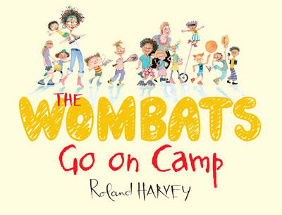The Wombats series by Roland Harvey

Allen & Unwin, 2014.
The Wombats go on camp. ISBN 9781760111533
The Wombats at the zoo. ISBN 9781743319048
(Age: Yr 2+) The Wombats are a group of kids and their two teachers,
Mrs Nott (Mumbat) and Ms Annabel. Naucia Compostine's a bit posh,
Audrey Gaudrey's a literary genius, and Hugh Jarmez is scared of
nothing. Ima Lemington loves baking, Oliver Hammenex is small and
fast, while Sardinia Jones likes to do magic tricks. Albert Onestein
knows everything, Dante Pozzebon's never without his ball, and
winning is very important to Ava Navratilova. Freddie Flannery has
one eye, Alecia Morosi hates everything, and Horrie Bull loves his
pet rat which is really an antechinus.
The Wombats Go on Camp is the first in this series by one of
Australia's best loved illustrators and in it the children go on
their very first camp with all the fun and games that can happen
there. Each child writes about the experience from their own
perspective and each entry is accompanied by the iconic style of
Harvey with its inimitable detail and humour. The format is the same
for The Wombats at the Zoo where each child is required to
write a report about their favourite animal, and through these,
Harvey embeds a lot of interesting facts.
However, rolling through both of them is Harvey's humour - in both
prose and picture there is much that will make the reader laugh out
loud. Starting with the careful choice of names for each child
through to Mrs Nott wishing she had not worn her zebra-like outfit
near the cheetahs, each page brings something to delight and engage.
Apart from the genius of Roland Harvey, it is this interesting
format that sets these two books apart from others that tell of
children visiting the zoo or going on camp.
While the multiple narrators might make it seem a bit tricky as a
read-aloud, an astute teacher could draw on what the listener
already knows about the character (from the endpaper introductions)
and combine this with a close examination of the accompanying
illustration to predict what the prose might be about. It could lead
to a discussion about perspective and how the same experience can be
viewed in many ways depending on the lens it is viewed through.
Similarly, it could also serve as a model for creating a class book
about similar excursions. The introductions to the children on the
endpapers reflect their knowledge and interest in the situation at
hand which could inspire the students to create a similar thumbnail
sketch of themselves and their perspectives, and provide the basis
for more interesting report writing.
This is a must-have to promote to teachers as a perfect vehicle for
entertainment and education!
Barbara Braxton